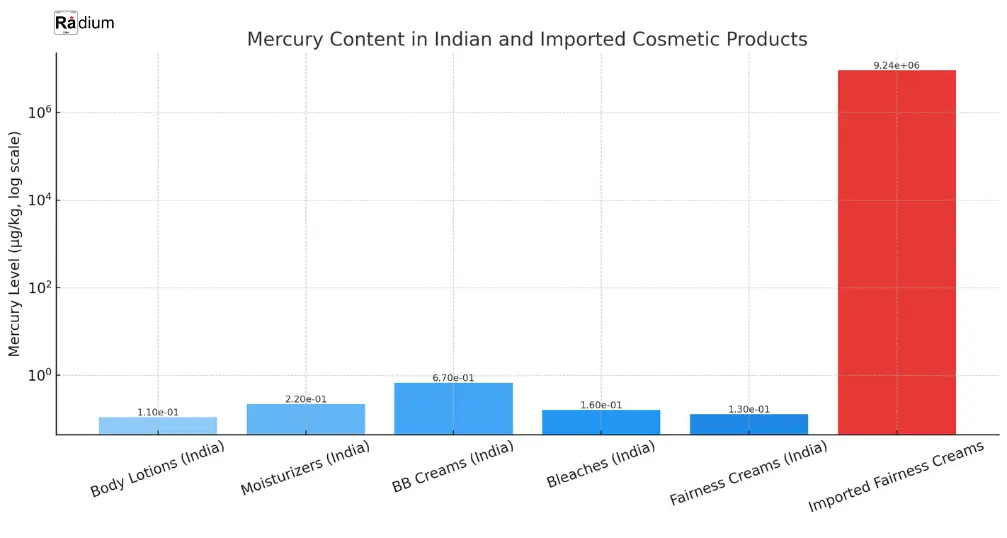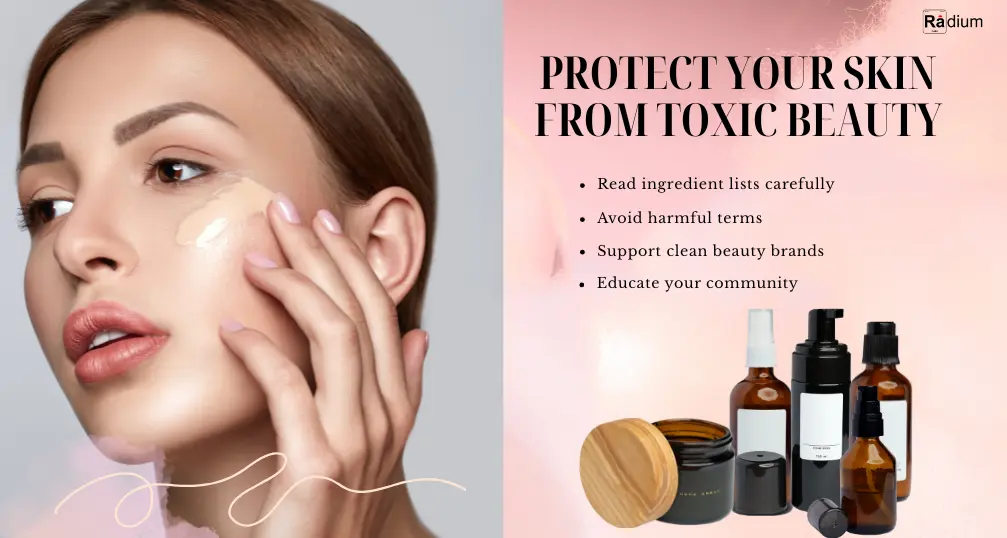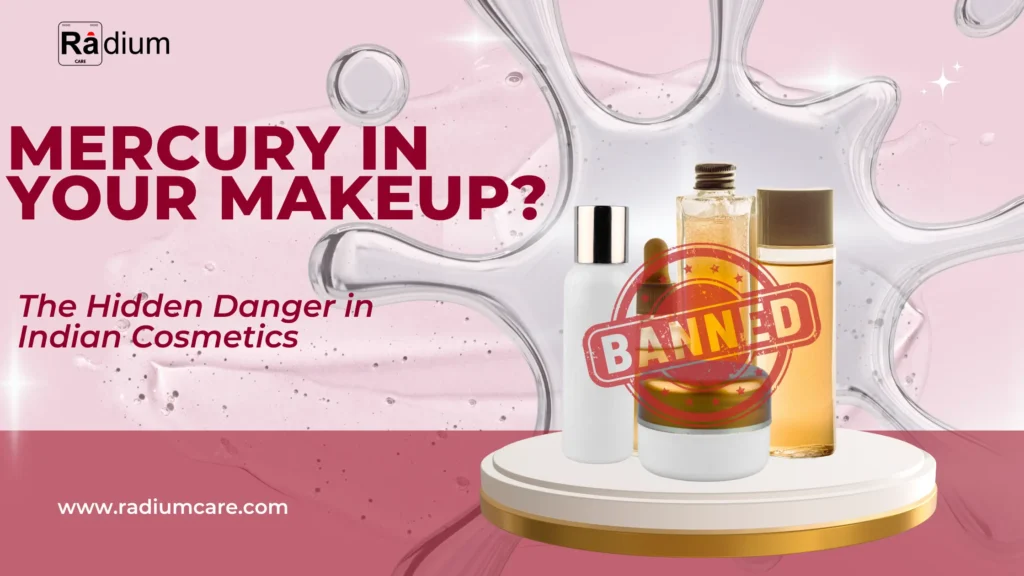Mercury, particularly in its inorganic and organic forms, is sometimes found in cosmetics, notably skin-lightening creams and as a preservative in eye area products. Its use in skin-lightening products is primarily to inhibit melanin production, leading to a lighter skin tone. But many countries and international treaties (i.e., the Minamata Convention) have prohibited or limited the use of mercury in cosmetics due to its toxic nature. In our present image-driven beauty world of perfection and flawless skin, pursuing youth has become instinctual! Sadly, the notion of perfection has become permanent! Emerging from the glitz of cosmetic branding and questionable airbrushed assurances is a shocking truth: mercury cosmetics — products that contain mercury, a known and deadly neurotoxin. This hidden face of toxic beauty is often overlooked in the race toward unattainable standards.The reckless use of mercury in skin lighteners and anti-aging creams may be common knowledge, and the consequences of mercury use can be terrifying. Mercury will enter your body, settle in the body, and can deliver detrimental health effects, including kidney injury and neurological concerns. Instead of limiting the use of mercury to existing legal limitations, unsafe goods containing mercury are still flooding India market and unsafe segments. Although mercury limits in cosmetics remain prevalent across the world, it is clear that India is taking notice.
Responding to alarming circumstances, the Indian government has responded, and with the DCGI’s (Drugs Controller General of India) strong recommendation to consider eliminating the use of mercury entirely in cosmetics, the proposals put forward for complete ban on the use of mercury is a positive step forward towards protecting consumers and in the ethical sale of cosmetic items.
Forms of Mercury in Cosmetics:
- Inorganic Mercury: Sometimes found in skin-lightening creams and soaps.
- Organic Mercury Compounds: It can be found in some makeup products for the eye area, such as mascara and eye makeup removers. Mercury is used as a preservative when other alternatives are not present. Thimerosal and phenyl mercuric salts are compounds that contain organic mercury.
Regulations and Limits:
- The Minamata Convention set the requirement that cosmetics must not be made, imported, or exported after 2020 if they contain mercury above 1 ppm (103 μg/kg) (except in cosmetics applied to the eye area.)
- The U.S. has a FDA limit of 1 ppm mercury in cosmetics (except in cosmetics made for the eye area, when it is being used as a preservative).
- The EU limit is 0.007% (by weight) of mercury in cosmetics and India has banned mercury in cosmetics, (except limited use of mercury as preservative in cosmetics for the eye area) like many other jurisdictions.
Health Concerns:
- Mercury is a known toxicant to the nervous system, kidneys, and skin.
- Methyl mercury affects fetuses, and causes developmental impacts.
- Mercury poisoning can cause difficulty concentrating, memory loss, anxiety, depression, headaches, and tremors.
Some literature suggests mercury poisoning can produce impacts in the digestive tract and cause damage to the liver, causing a range of gastrointestinal problems.
The Price of “Flawless”: What’s Really in Your Cosmetics?
Beauty often comes at a cost — sometimes not just figuratively, as is the case with mercury. While not terribly uncommon, mercury is far from benign. Historically, mercury has been favored for its antimicrobial qualities and for suppressing melanin production, and so has found its way into many forms of cosmetic products. It is found most often in products that promise anti-aging miracles, or lighter and brighter skin. On appearance, the benefits sound appealing; however, the risks are chilling. Mercury exposure from prolonged use of such products can result in damage to the kidneys; attack on the immune system; neurological injury leading to tremors or memory loss… the possible consequences are extensive. In some cases, it even causes irreversible skin scarring. The pursuit of beauty shouldn’t be a gamble with your health—but with mercury, it too often becomes exactly that.These dangers highlight a growing concern around cosmetic safety, especially as unregulated products continue to reach the hands of unaware consumers.
What the Rules Say—And Why They Fall Short
Currently, a variety of regulations, and specifically the regulations under the Minamata Convention on Mercury, usually prohibit the manufacturing, importing, and exporting of cosmetics made from or containing mercury above 1 part per million (ppm). The regulations generally ban skin lightening products, which could include creams, and soaps. Eye area cosmetics are permitted to include mercury under some circumstances as long as it is used as a preservative when no safe alternatives exist. The phase outs demonstrate the ongoing efforts to eradicate mercury in cosmetics and its effects.
The DCGI Steps Up: A Ban Worth Applauding
In a landmark move to prioritize public health, a government subcommittee has proposed a comprehensive ban on the manufacturing, import, and export of cosmetic products containing more than 1 part per million (ppm) of mercury. This bold move aims to reinforce existing regulations and limit the unregulated use of this dangerous heavy metal in beauty products. More importantly, it puts India in line with the Minamata Convention on Mercury, an international treaty that will see the use of mercury in cosmetics banned by 2025. By complying with the agreement, India is taking a preemptive move to protect consumers from toxic exposures and signal its intention to use safer, more transparent beauty standards.
The Invisible Damage: Mercury’s Real Toll on Health
While mercury might feel considerably silky, it opens up the doors to numerous long-term, not-so-smooth consequences. Regular use of a mercury-containing cosmetic will eventually lead to serious neurological problems such as tremors, memory issues and unpredictable changes.Also, kidney problems and a broken immune system that doesn’t allow your body to fight off infection. Symptoms that may be noticed on the skin include thinning of the skin, rashes that don’t resolve, scarring (that won’t go away), and also lessen the beauty you are trying to achieve. Beyond physical damage lies an equally troubling psychological toll—particularly for women and young people pressured to conform to narrow ideals glorified by the beauty industry. In the relentless pursuit of perfection, mercury turns allure into risk, masking health hazards behind polished packaging and misleading labels.
Mercury Levels in Cosmetics: A Toxic Divide
A recent study reveals striking differences in mercury levels in both Indian and imported cosmetic products. While Indian body lotions, moisturizers, BB creams, bleaches, and fairness creams contained low levels of mercury (with values in the 0.11-0.67 µg/kg range), many imported fairness creams averaged 9.24 million µg/kg (9,240 ppm)—over 9,000 times the legal limit (1 ppm).Exposure to a shocking concentration of mercury is a danger to beauty and has a hazard quotient exceeding 100, which is associated with severe risk for health effects including but not limited to kidney injury, neurological injury, or lifetime skin damage. The findings underscore the need for increased cosmetic safety legislation, including possible limits on foreign products, testing for hazardous materials, and transparency to prevent consumers in India from exposure to toxic skin products.

Fairness Creams Under Fire
Mercury’s most nefarious hiding place is skin-lightening products—the dazzling veneer of a billion-dollar market founded upon insidious colorism and beauty bias. In Indian culture, fair skin has traditionally been synonymous with success, desirability, and higher caste status—all notions that have been bolstered by everything from matrimonial advertisements to television commercials.Many fairness creams take advantage of these insecurities by labeling their products ‘whitening’ or ‘radiant glow’ and sometimes don’t disclose that they have dangerous amounts of mercury. This indicates a serious beauty risk, where products that are intended to improve your complexion change or worsen it – causing irreversible damage causing damage to your skin, health, and mental health. The need for a safe skin-care alternative is imperative. These creams do more than lighten skin—they darken the line between beauty and harm, all while keeping toxic standards alive in a jar.
New Enforcement Playbook: Self-Reporting and Surprise Audits
To effectively implement the proposed mercury ban, regulators are adopting a rigorous two-pronged enforcement strategy.In the first place, the self-declaration requirement will oblige all makers of cosmetics to disclose the mercury in their products, as well as submit a plan to eliminate mercury in their products. Secondly, The Central Drugs Standard Control Organisation (CDSCO), is ready to random sample and unannounced inspect their products, to find products not in compliance, and get them off the marketplace, to prevent them from getting to you. From government reports, companies will not have the luxury of time—the regulator will give strict timelines to phase out mercury entirely from cosmetic lines.The announcement of the government banning mercury-containing products in India is a huge development that marks a shift in regulatory oversight, and demonstrates the government’s commitment to safer, toxic-free beauty standards.
A Global Campaign: India’s Role in the Minamata Convention
The world has already started to push toward a mercury-free marketplace; the Minamata Convention on Mercury, signed in 2013, is a legally binding treaty involving over 140 nations including India, and the Minamata Convention required countries to outright ban mercury in cosmetic products by 2025.
The Indian government’s ban on mercury products is not just about regulating India’s domestic market; it is about taking a stance for leading the world toward ethical beauty and towards a collective wellness for the environment.
Why Consumers Keep Using Mercury Products

- Misleading Labels
- Often the dangerous ingredients of products are concealed under complicated chemical names or undisclosed proprietary names.
- It can also include packaging that omits important considerations concerning safety or makes misleading advertising claims (e.g., “all-natural,” “safe”).
- Cultural Pressure
- Despite feminine beauty being a common construct, “fairness” or “whiteness” is generally an irrationally privileged social construct tied to social mobility and success.
- The role that our media, advertising and even wedding culture plays in upholding colorist ideals, might complicate the meaning of beauty for many women of color.
- Lack of Awareness
- Most consumers do not understand the negative health impacts of mercury-consumption products.
- There is also a low level of ingredient literacy; for example, people do not understand how to make sense of labels on products.
- Systemic Issues
- A perfect storm of high-pressure global promotion, disinformation, systemic and social discrimination maintains high demand.
- Also, regulatory neglect allows illicit products to be sold on the market.
Your Skin, Your Power: How to Protect Yourself
- Read ingredient lists carefully
- Look beyond marketing claims and check for hidden toxins.
- Avoid harmful terms
- Do not use a product that lists “mercury,” “calomel,” “mercurous chloride,” or “ammoniated mercury.”
- Support clean beauty brands
- Choose companies that prioritize transparency and non-toxic formulations.
- Report suspicious products
- Report unsafe products to the CDSCO or local health authority.
- Educate your community
- Spread awareness – because awareness is the biggest and strongest layer of protection.
Looking Ahead: Toward a Cleaner, Safer Beauty Future
India’s regulatory shift is a huge step – but true change requires more than regulation. In order to protect consumers and change industry practices, we need:
- Bold public education campaigns
- Awareness of mercury risks and the safety of ingredients.
- Stronger laws with enforcement power
- There should be real consequences for violations.
- Support for small businesses
- They are in need of support to transit to safe alternatives with no mercury.
- Consumer-driven demand
- We should demand cleaner, ethical, and transparent beauty products.
This isn’t only about mercury – it’s about ensuring that the beauty industry is accountable and creating a culture that values health over beauty, integrity over egoism and authenticity over pretend self-love.
Final Word: Beauty Without Toxicity
True beauty is not in the list of ingredients, but in authenticity, safety, and being who we are. India has now banned mercury in cosmetics, which signifies more than a regulatory reform; it signifies a cultural awakening. This step at the beginning of a huge shift is contradicting old ideas that beauty must equate fairness or lack of flaws and is pushing consumers to judge the products they rely on. It’s encouraging consumers to prioritize their health over the harmful standards. It goes on to redefine what self-care means to consumers—this is bigger than what a consumer puts on their skin, and more about what we believe about beauty, worth, and value.
FAQ’s
Que: Why is mercury found in some cosmetic products?
Ans: Mercury has historically been popular because of its antimicrobial properties and ability to inhibit melanin production (leading to skin lightening and reversing the look of aging skin). Mercury is commonly found in skin-lightening and anti-aging creams.
Que: What are the health risks of using mercury-containing cosmetics?
Ans: Possible health effects include impaired kidney function, attack on the immune system, neurological harm including tremors and memory problems, and permanent scarring.
Que: Why do consumers continue to use mercury products despite the risks?
Ans: Sometimes it is caused by misleading labels, sometimes by societal pressure to attain a “fair” complexion, sometimes the person is unaware of the health risks, sometimes it is due to structural factors contributing to or allowing the presence of illicit products.
Que: How can consumers protect themselves from mercury in cosmetics?
Ans: Read the ingredient label, if you see the word “mercury” anywhere in the ingredient list do not use it! Look for reputable and clean beauty brands, educate yourself and others, and report suspicious products to the Central Drugs Standard Control Organization (CDSCO).
Que: Which cosmetic products are most likely to contain mercury?
Ans: Skin lightening products (fairness creams) were often found to contain mercury and anti-aging creams.

